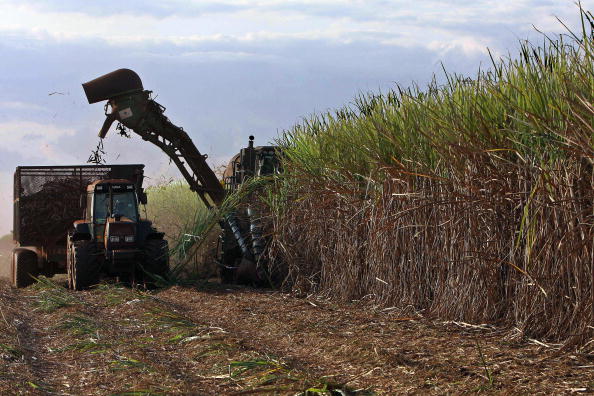 http://en.wikipedia.org/wiki/Anaerobic_digestion
http://en.wikipedia.org/wiki/Anaerobic_digestion
Biogas FAQ
What is biogas?
Biogas is a byproduct of the decomposition of organic matter by anaerobic bacteria.
Biogas is typically composed of 60% methane and 40% CO2. It is similar to natural gas which is composed of 99% methane.
Biogas is a clean and renewable energy that may be substituted to natural gas to cook, to produce vapor, hot water or to generate electricity.
At room pressure and temperature biogas is in gaseous form, not liquid like LPG (propane). Bottling biogas is a very expensive process.
How does it work?
Organic waste is put into a sealed tank called a digester (or bioreactor) where it is heated and agitated. In the absence of oxygen anaerobic bacteria consume the organic matter to multiply and produce biogas.
What type of waste produces biogas?
Any organic waste has the ability to produce biogas: human excreta, manure, animal slurry, fruit and vegetable waste, slaughterhouse waste, meat packing waste, dairy factory waste, brewery and distillery waste, etc.
Fiber rich wastes like wood, leaves, etc. make poor feedstocks for digesters as they are difficult to digest.
How much biogas can I get out of my waste?
The amount of biogas you can extract from your organic waste depends on the waste itself and the design of the digester system.
Some digesters can yield 20 m3 of biogas per tonne of waste while others can yield as much as 800 m3 per tonne.
It all depends on waste quality, digester design and proper operation of the system.
Where is biogas produced?
Biogas is normally produced in nature by the anaerobic degradation of organic waste in soil, marshes, ocean, etc.
Biogas is also produced in landfills where organic food waste degrades in anaerobic conditions.
Biogas can be produced in anaerobic digesters. These are equipment (tanks) providing full control of the process and ensuring full biogas recovery.
Since methane is a potent greenhouse gas, isn’t it stupid to produce biogas?
Methane has a greenhouse gas (GHG) heating factor 21 times higher than CO2.
Combustion of biogas converts methane into CO2 and reduces the GHG impact by over 20 times.
By extracting methane out of waste and using it to produce heat and/or electricity we ensure that the waste will not degrade in an open environment therefore reducing direct methane atmospheric emissions. Moreover, the energy provided by the biogas is likely to displace fossil fuel which is the main contributor to GHG emissions.
Biogas energy is considered carbon neutral, since carbon emitted by its combustion comes from carbon fixed by plants (natural carbon cycle).
How much energy is in biogas?
Each cubic meter (m3) of biogas contains the equivalent of 6 kWh of calorific energy.
However, when we convert biogas to electricity, in a biogas powered electric generator, we get about 2 kWh of useable electricity, the rest turns into heat which can also be used for heating applications.
2 kWh is enough energy to power a 100 W light bulb for 20 hours or a 2000W hair dryer for 1 hour.
What happens to the waste after digestion?
Despite popular belief, the amount of waste going in the digester is almost equal to the amount coming out. However the quality of the waste is altered for the better (less odor, better fertilizer, organic load reduced, less polluting)
Waste coming out of the digester can be separated (solid/liquid):the solid part can be composted and the liquid part can be used as liquid fertilizer or can be treated further and disposed.
So why make biogas?
It always costs money to get rid of waste. If it doesn’t cost you anything, you are probably creating an environmental hazard.
By putting a digester in your waste treatment chain you introduce a potential revenue center.
For example:
On a farm the manure is not considered to be a waste but a fertilizer. By installing a digester the farmer can profit from the biogas by reducing odors and enhancing the fertilizing value of the manure.
In an agro-food industry the digester can be used as a primary waste treatment unit where the biogas is used to offset some energy cost in the plant and to reduce the size of the secondary waste treatment.
How much does it cost and how much can I make?
Biogas plants can take various shapes and forms.
A simple agricultural plant could cost as low as $3,500 per electrical kW installed. Municipal food waste plant can cost up to $19,000/kWe installed!
Every project is different. A typical payback on a biogas plant is 7 years.
Biogas systems are significant capital investments that require careful planning to maximize the chances of success.
If you feel exposed to energy price fluctuation and you have an environmental conscience about your waste then a biogas plant could be a sustainable solution for you.
OK I’m interested. Send me info on your technology.
Electrigaz is an independent firm and does not represent any equipment manufacturer. We do not receive commissions on equipment recommended to our clients.
Electrigaz does not sell equipment, we sell expertise.
We work for you and guide you in your biogas project planning.
All biogas systems are customized to fit your needs. Every biogas system is unique, because everyone’s waste quantity and quality is different.
To ensure the economic viability of the system great care must go in the study, design, construction and operation of the biogas plant.
Electrigaz provides a slew of services to guide you in the development of your biogas project.
Can I make a biogas plant myself?
Yes, if you have time and money you can surely make one. You will have to educate yourself on the intricacies of a biogas plant design, build a plan, research equipment, find suppliers, hire engineers and contractors, get permits, get financing, negotiate energy contracts, perform construction supervision, register your project for greenhouse gas credits, etc.
Or you can hire Electrigaz. Remember Biogas is our business!
We also offer educational services (seminars) for those who are determined to build their own biogas system.
How long does it take to build a biogas plant?
For a moderate to large scale digester (300 m3 +) it will typically take, from the first call to a running biogas plant, anywhere from 8 months to 2 years.
If you are interested in building a small family size digester (10 m3 or less) you can count about 1 to 2 months until you have a functioning biogas plant.
How difficult is it to run a biogas plant?
A biogas plant is like an animal. You must feed it every day and feed it the right stuff in the right amount. Just like an animal if you don’t take good care of it, it will become ill and will yield poor results.
How much do you charge for engineering a biogas plant?
Typically engineering fees will run between 5% to 12% of overall project cost.
Ok I’m interested in your services, what are the steps?
PRELIMINARY EVALUATION
You contact us and tell us everything about your waste (type, daily quantities, physical properties, etc.) We will also need to know your energy needs and what you intend to do with the biogas: convert to electricity, heat, cooking, etc.
Electrigaz team than performs a preliminary evaluation, free of charge, to check if your project is viable at all.
PRELIMINARY ENGINEERING
If the project appears viable, you can than hire Electrigaz to produce a preliminary engineering report to size and price your project. This will be essential documentation for you to raise capital for your project. A typical cost for this report is between $7,500 to $25,000 USD, depending on project size and complexity.
Typically, financial institutions will require you to lock up construction permits, feedstock supply agreements, energy purchase agreements, and environmental authorization before they provide funds.
Additional “detailed” engineering may be required to obtain all necessary pre-requisites and secure funds. You should plan a budget for this additional engineering.
DETAILED ENGINEERING, PROCUREMENT & CONSTRUCTION
You have secured financing and want to start building your biogas plant.
You will require complete plans, tender documents and equipment specifications to hire the right contractors and buy the right equipment.
Some of our clients want to manage the construction themselves. In this case, we provide sporadic site supervision to ensure proper implementation.
If you don’t want to get involved with the construction, you can hire Electrigaz to project manage equipment procurement and construction for you. We will make sure the project progresses as smoothly as possible and will tell you when to pay whom.
BIOGAS PLANT STARTUP
Electrigaz strongly suggests you hire us to perform plant commissioning and startup
Since when is biogas used by humans?
The formation of biogas is a natural phenomenon that naturally occurs in wetland, manure stack, human and animal intestines. For centuries, humans have harvested the power of bacteriological digestion, by recovering naturally formed biogas to use for lighting, cooking, heating or to power mechanical engines.
In Asia, millions of family digesters were built to provide cooking fuel and lighting in rural areas. During the Second World War, German army trucks were fueled with biogas collected from farmers manure (gas engine).
Over the last 50 years remarkable progress has been made in the development of anaerobic digesters (bioreactors) to increase methane (CH4) yield and improve its process flow technologies.
Nowadays, thousands of projects around the world, from small dairy farms to large municipal waste water treatment plants, are demonstrating that biogas recovery systems are environmentally and economically sound. In Europe, villages are entirely supplied in electricity and heat from their local centralized biogas pant.
What about Bio-Hydrogen (BioH2)?
Today, ground breaking biotechnology discoveries have brought new hope for the hydrogen (H2) economy. Bacteriological digestion/fermentation of organic waste holds the promise of biological production of H2.
The clear advantage of bio-hydrogen over biogas is that BioH2 produces virtually no greenhouse gases.
Electrigaz thrives to become a world leading expert in the field of biological hydrogen (BioH2) production processes.
Can biogas be used in fuel cells?
A fuel cell is a system that directly converts a gaseous chemical reaction into electricity. In a typical fuel cell, pure hydrogen (H2) reacts with oxygen (O2) from the air to create water (H2O), heat and electricity.
Solid oxide fuel cells (SOFC) can convert cleaned up biogas directly into electricity.
Before the advent of fuel cell technology, internal combustion engine generators were the sole alternative for conversion of bio-methane into heat and electricity with a typical 25 to 40 % efficiency range.
Today, several companies offer direct methane fuel cell systems for silent production of green energy from bio-methane.
Because pure hydrogen fuel cells offer biogas-electrical conversion efficiency in the 50% to 60% range, Electrigaz foresees tremendous opportunities in the marriage of BioH2 digestion and fuel cell technologies.





 A l'occasion de la conférence bretonne de l'énergie qui s'est tenue vendredi dernier à Rennes, le préfet de Région Michel Cadot, a confirmé la construction d'une «unité de production d'appoint» dans la région de Brest.
A l'occasion de la conférence bretonne de l'énergie qui s'est tenue vendredi dernier à Rennes, le préfet de Région Michel Cadot, a confirmé la construction d'une «unité de production d'appoint» dans la région de Brest.
 Une première en France Les hasards du calendrier ont voulu que, consécutivement au vote de la Loi Grenelle 2 en juillet dernier, le centre de valorisation organique soit autorisé au même moment à injecter son biogaz dans les réseaux de GRDF. Reste à attendre les résultats des ultimes tests relatifs aux taux de fluor et de chlore. GRDF est désormais obligé de racheter cette production à LMCU. Le prix de vente est d’actuellement 0.25 centimes le kilowatt/heure. Lorsque le décret d’application de la loi sera publié, le tarif sera alors bonifié, passant à 50 centimes/Kw/h, soit une recette pour LMCU de 2 millions d’euros par an. Les bus rouleront alors avec un mélange de gaz naturel et de biogaz. A terme la production de gaz-carburant du CVO permettra de faire rouler l’équivalent de 100 bus, soit un quart de la flotte, contre une trentaine dans un premier temps. Elle passera de 200 m3 par heure à 750.
Une première en France Les hasards du calendrier ont voulu que, consécutivement au vote de la Loi Grenelle 2 en juillet dernier, le centre de valorisation organique soit autorisé au même moment à injecter son biogaz dans les réseaux de GRDF. Reste à attendre les résultats des ultimes tests relatifs aux taux de fluor et de chlore. GRDF est désormais obligé de racheter cette production à LMCU. Le prix de vente est d’actuellement 0.25 centimes le kilowatt/heure. Lorsque le décret d’application de la loi sera publié, le tarif sera alors bonifié, passant à 50 centimes/Kw/h, soit une recette pour LMCU de 2 millions d’euros par an. Les bus rouleront alors avec un mélange de gaz naturel et de biogaz. A terme la production de gaz-carburant du CVO permettra de faire rouler l’équivalent de 100 bus, soit un quart de la flotte, contre une trentaine dans un premier temps. Elle passera de 200 m3 par heure à 750. 














 L’industrie électrique du Québec cherche constamment à innover pour favoriser un avenir énergétique durable. Récemment, plusieurs innovations visent le développement de réseaux électriques intelligents aussi connus sous le nom de Smart Grid.
L’industrie électrique du Québec cherche constamment à innover pour favoriser un avenir énergétique durable. Récemment, plusieurs innovations visent le développement de réseaux électriques intelligents aussi connus sous le nom de Smart Grid.